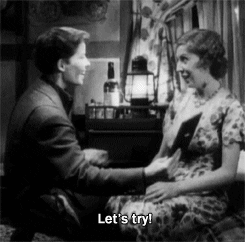In 1935, “Sylvia Scarlett“ premiered—an epic financial flop of a movie about a woman (played by Katherine Hepburn) who decides that she can help her debt-ridden father by dressing like a young man in order to commit crime more easily (#begaydocrime really rings true, doesn’t it?). In the process, she explores life as a man, and experiences changes in her relationship towards masculine presentation, and to women as romantic interests. A relic of the 1930’s, the movie unfortunately does not end with Sylvia continuing to explore gender fluidity and becoming a crime boss, but ends with her falling for a man and “becoming a woman again.”

The film was a powerhouse of queer production, pushing progressive sexual politics that were received very poorly at the time of release. In fact, it is the film’s poor reception that tells us most about its vibrantly queer cultural status. Variety wrote at the time: “Perhaps it is not valid to ask whether anybody would really fail to suspect the true sex of such a boy as [Katherine] Hepburn looks and acts. But while carrying this off well enough, she shines brightest and is most likeable in the transition [back] into womanhood.”
By virtue of its 1935 production, the film also narrowly caught to introduction of the 1934 Hays Code. Capitulating to the growing political influence of the Catholic Church, the U.S. Government used the Hays Code to crack down on “immorality” in cinema, which included positive depictions of queer identities, interracial relationships and nudity, among other such sins. Even though the Hays Code demanded incredible restraint in “Sylvia Scarlett'”s portrayal of sexuality, the premiere date meant that the height of the cinematic purity movement would coincide with Sylvia Scarlett’s ill-fated debut.
“Sylvia Scarlett” was directed by gay bon vivant George Cukor, and it starred open-secret queers Katherine Hepburn and Cary Grant. The film also employed women and prominent leftists in its production; it was written in part by Gladys Unger, edited by Jane Loring, and also featured narrative contributions by Mortimer Offner, a member of the Communist Party who was later blacklisted from Hollywood during the Red Scare.
During the 1940s and 1950s, Senator Joseph McCarthy capitalized on Cold War paranoia to lead a witch-hunt of prominent leftists and LGBTQ people across all industries, but particularly in the government, activism, and in the arts. He administrated hundreds of trials and targeted people from Lucille Ball to Pete Seeger. The Red Scare eventually became so intense that the same company that let a gay communist produce “Sylvia Scarlett” released a drama called “I Married a Communist!” 15 years later.
So all evidence provided for, it can be reasonably concluded: even if no one remembers this obscure film that didn’t even make $500,000 at the box office, “Sylvia Scarlett” was, like, super gay.
The Infamous Kiss Scene
The film’s gay reputation was firmly anchored by one iconic moment. In the scene that it is rumored to have caused three-quarters of the audience to walk out of a test screening, seductive maid Maudie kisses Sylvia Scarlett while she is disguised as Sylvester.
Maudie [to Sylvester]: When are you going to grow some whiskers? Your face is as smooth as a girl’s. You’ll be bristly soon enough!
Sylvester: I intend to grow a mustache in a year or two.
Maudie: You won’t half look a lad! What are you gonna have? A Charlie Chaplin?
Sylvester: No, one of those thin ones.
Maudie: Like Ronald Coleman? Where’s me eyebrow pencil? Let’s see how it’ll look.
[Sylvester and Maudie sit together, and Sylvester grabs a hand mirror as Maudie draws a mustache.]
Sylvester: Ow!
Maudie: Hold still now. Wait a minute. Let me get it right.
Sylvester [looking in the mirror]: Oh, I say, that’s marvelous.
Maudie: I say, I wonder what it’d be like to kiss anybody with a mustache like that.
Sylvester: I don’t know.
Maudie: Let’s try.
[Maudie kisses Sylvester.]
Sure, the movie was branded “career poison” for Hepburn, Cukor never worked at RKO Pictures again, and Grant and Hepburn begged the producer to shelve the film after the homophobic reception at a test screening, but the movie still stands as a monument to the sapphic impression Hepburn left in Hollywood, a legacy not only of incredible beauty but of handsomeness as well.
For more information about the history of this movie, a great resource is “Queer & Now & Then: 1935,” a review by Michael Koresky from Film Comment.
